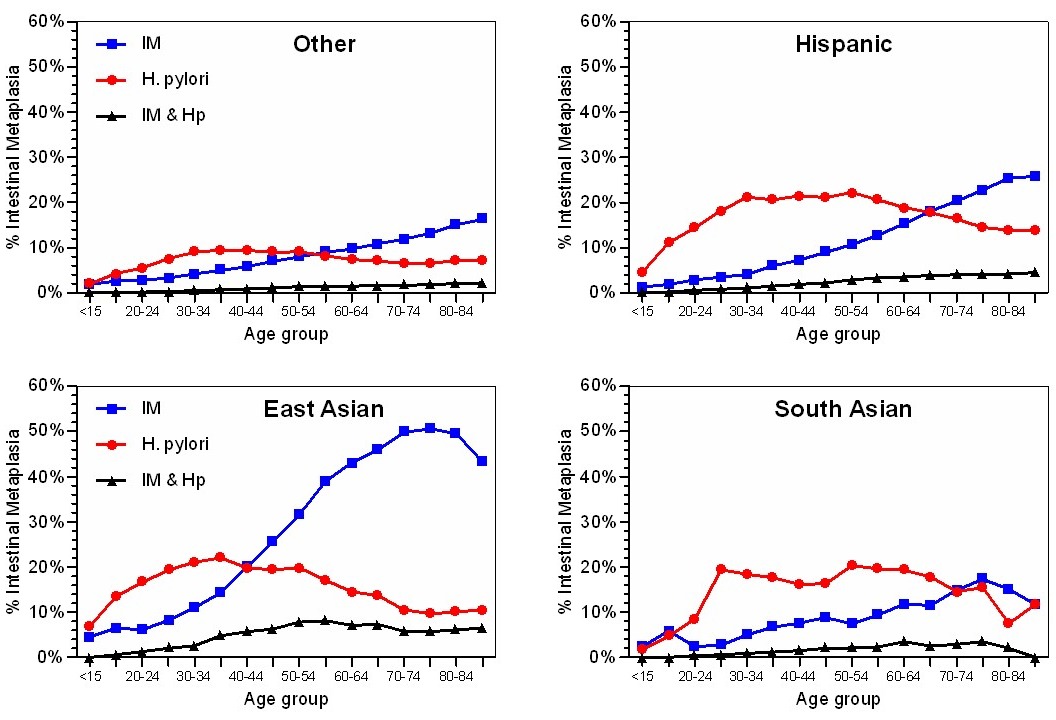Tuesday Poster Session
Category: Stomach
P5046 - Epidemiologic Features of Gastric Intestinal Metaplasia in Outpatient Endoscopy Centers Across the United States
Tuesday, October 29, 2024
10:30 AM - 4:00 PM ET
Location: Exhibit Hall E

Has Audio

Amnon Sonnenberg, MD, MSc
Oregon Health & Science University
Portland, OR
Presenting Author(s)
Robert M. Genta, MD1, Anuradha Singhal, MD1, Amnon Sonnenberg, MD, MSc2
1Inform Diagnostics, Irving, TX; 2Oregon Health & Science University, Portland, OR
Introduction: The aim of the present study was to analyze the demographic characteristics of patients with intestinal metaplasia of the stomach in an outpatient population from a large variety of endoscopy centers distributed throughout the United States.
Methods: Inform Diagnostics is a specialized pathology laboratory serving outpatient endoscopy centers throughout the United States. The study included all 1,882,800 patients who underwent an esophago-gastro-duodenoscopy (EGD) with gastric biopsies between 01/01/2009 and 12/31/2019. Patients were stratified by gender, age, and ethnicity. Student’s t-tests and odds ratios (OR) with their 95% confidence intervals (CI) were used for statistical comparison.
Results: The study population comprised 1,882,800 unique patients with gastric biopsies, of whom 222,565 were identified as Hispanics (11.8%), 53,506 as East Asians (2.8%), and 9,388 as South Asians (0.5%). These 3 ethnic subgroups were compared to the remainder of 1,597,341 (84.8%) Others (of mostly Caucasian or African American ethnicity). Intestinal metaplasia was significantly more common in East Asians (36.2%) and Hispanics (12.5%) than in South Asians (9.1%) or Other ethnicities (9.0%, reference). Similarly, H. pylori was significantly more common in East Asians (15.9%), Hispanics (19.0%), and South Asians (16.9%) than Others (7.8%, reference). Intestinal metaplasia was significantly more common in men (11.1%) than women (9.6%), with OR=1.18, CI: 1.17–1.19. H. pylori was also significantly more common in men (10.2%) than women (8.8%), with OR=1.11, 1.16–1.18. Similar gender distributions were found in all ethnic groups alike. In all ethnic groups alike, the frequencies of intestinal metaplasia alone and intestinal metaplasia plus H. pylori were characterized by a significant age-dependent rise (Figure). In all ethnic groups alike, the frequency of H. pylori infection showed an initial significant age-dependent rise that subsequently levelled off and then declined in the oldest age groups. Compared with the other ethnic groups, the age-dependent rise of intestinal metaplasia was most pronounced among East Asians.
Discussion: Our study shows that the occurrence of gastric intestinal metaplasia in the United States is markedly influenced by patients’ demographic characteristics. Intestinal metaplasia is more common in men, elderly patients, and ethnic minorities, such as East Asians and Hispanics.

Disclosures:
Robert M. Genta, MD1, Anuradha Singhal, MD1, Amnon Sonnenberg, MD, MSc2. P5046 - Epidemiologic Features of Gastric Intestinal Metaplasia in Outpatient Endoscopy Centers Across the United States, ACG 2024 Annual Scientific Meeting Abstracts. Philadelphia, PA: American College of Gastroenterology.
1Inform Diagnostics, Irving, TX; 2Oregon Health & Science University, Portland, OR
Introduction: The aim of the present study was to analyze the demographic characteristics of patients with intestinal metaplasia of the stomach in an outpatient population from a large variety of endoscopy centers distributed throughout the United States.
Methods: Inform Diagnostics is a specialized pathology laboratory serving outpatient endoscopy centers throughout the United States. The study included all 1,882,800 patients who underwent an esophago-gastro-duodenoscopy (EGD) with gastric biopsies between 01/01/2009 and 12/31/2019. Patients were stratified by gender, age, and ethnicity. Student’s t-tests and odds ratios (OR) with their 95% confidence intervals (CI) were used for statistical comparison.
Results: The study population comprised 1,882,800 unique patients with gastric biopsies, of whom 222,565 were identified as Hispanics (11.8%), 53,506 as East Asians (2.8%), and 9,388 as South Asians (0.5%). These 3 ethnic subgroups were compared to the remainder of 1,597,341 (84.8%) Others (of mostly Caucasian or African American ethnicity). Intestinal metaplasia was significantly more common in East Asians (36.2%) and Hispanics (12.5%) than in South Asians (9.1%) or Other ethnicities (9.0%, reference). Similarly, H. pylori was significantly more common in East Asians (15.9%), Hispanics (19.0%), and South Asians (16.9%) than Others (7.8%, reference). Intestinal metaplasia was significantly more common in men (11.1%) than women (9.6%), with OR=1.18, CI: 1.17–1.19. H. pylori was also significantly more common in men (10.2%) than women (8.8%), with OR=1.11, 1.16–1.18. Similar gender distributions were found in all ethnic groups alike. In all ethnic groups alike, the frequencies of intestinal metaplasia alone and intestinal metaplasia plus H. pylori were characterized by a significant age-dependent rise (Figure). In all ethnic groups alike, the frequency of H. pylori infection showed an initial significant age-dependent rise that subsequently levelled off and then declined in the oldest age groups. Compared with the other ethnic groups, the age-dependent rise of intestinal metaplasia was most pronounced among East Asians.
Discussion: Our study shows that the occurrence of gastric intestinal metaplasia in the United States is markedly influenced by patients’ demographic characteristics. Intestinal metaplasia is more common in men, elderly patients, and ethnic minorities, such as East Asians and Hispanics.

Figure: Age-dependent distributions of gastric intestinal metaplasia (IM), H. pylori infection (Hp), and the concurrence of IM and Hp (IM & Hp), separately shown in 4 different ethnic groups.
Disclosures:
Robert Genta indicated no relevant financial relationships.
Anuradha Singhal indicated no relevant financial relationships.
Amnon Sonnenberg indicated no relevant financial relationships.
Robert M. Genta, MD1, Anuradha Singhal, MD1, Amnon Sonnenberg, MD, MSc2. P5046 - Epidemiologic Features of Gastric Intestinal Metaplasia in Outpatient Endoscopy Centers Across the United States, ACG 2024 Annual Scientific Meeting Abstracts. Philadelphia, PA: American College of Gastroenterology.
